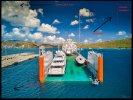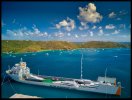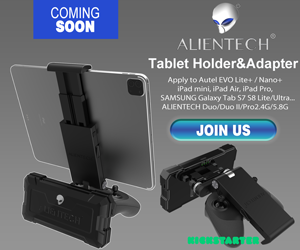I thought we had a great discussion on ND filters and a lot of myths and misinformation was brought to light in my last food for thought thread where I discussed why I never use ND filters with drone cameras. One thing that came up a few times in that thread was using Circular Polarizing Lenses (CPLs) with drone cameras. So this week I thought I'd discuss why I never use CPLs with my drone cameras. Keep in mind this perspective is from a commercial photography/videography viewpoint, but the information could be useful to pretty much anyone considering using a CPL with their drone camera(s).
DEFINITION
A circular polarizer lens also known as a CPL for short is designed to remove reflections from the subject material. Reflections are typically caused when the sun hits a reflective object and the light from that object is captured by the lens. The end result of this is typically less appealing colors on bright sunny cloudless days, harsh reflections, and color loss due to reduced contrast.
HOW THEY WORK
Circular Polarizers consist of two pieces of glass (or plastic but hopefully glass) which are used to filter out light that has become polarized due to reflection from a non-metallic surface. In laymen's terms if light is reflecting off of certain surfaces it becomes polarized and the CPL can filter out the reflected light. CPL's, due to the filtering mechanism also tend to reduce the amount of light that hits the camera sensor by 1 or 2 stops.
There is one major catch to the way they work that for me eliminates them from being a viable solution for commercial drone photography or commercially viable video. A CPL needs its outer element to be rotated until it is 90 degrees in relation to the sun in order to filter out the polarized light. Even when filming from the ground, you do not typically use a CPL for sunrise or sunset footage because the sun is not at the proper angle in relation to the CPL.
DRONE USAGE
There are many CPL vendors for drone cameras including the EVO II series of drones. As I alluded to earlier, the problem with CPLs is that the front element must be rotated until it is 90 degrees in relation to the sun in order to get the full polarization effect.
The problem with this 90 degree requirement when it comes to drone cameras is that it is nearly impossible to predict what angle in relation to the sun the drone's camera will be when it is in the air and preparing to film a target subject.
This problem becomes much worse when filming video, as the drone rotates in relation to the sun and/or the camera tilts up or down, the strength of the CPL will fluctuate which could completely ruin an otherwise perfectly good take.
There is one possible scenario where the sun is at the proper angle, the CPL is properly rotated, and the drone takes off and flies in a straight line to the subject material without tilting the camera or turning the drone then flies straight back and lands. In this scenario the CPL could provide some benefit but in the real world this scenario is very limited and unlikely.
OTHER PROBLEMS
The problems with CPLs do not stop there. CPLs, just like ND filters, can introduce a whole host of other problems to your footage that would have been avoided if they were not used. Below is a list of some of those possible issues.


HOW TO GET THE BEST FOOTAGE WITHOUT A CPL
So now that you are aware of the damage a CPL can cause....I'm sure you must be asking; what do I do on those bright sunny cloudless days when the sun is reflecting off of the water/snow/shiny surface? Below is how I personally handle those situations:
Hopefully this post helps someone or some people get better footage from their drones. I personally have never even owned a drone CPL and I honestly rarely use CPLs even for my regular work. I mostly film people more so than landscapes or nature scenes and the last thing I want is to use a filter that could affect skin tones.
SPECIAL THANKS
I wish to thank @DsPallasVI for letting me use his images to demonstrate the problems a CPL can cause.
IN CASE YOU MISSED IT
Why I Never Shoot Video At 24FPS
Autel EVO II Pro - User Experience from a DJI User
EXPLORE YOUR WORLD: An Autel EVO II Pro 6K Cinematic Story
Why I ALWAYS use Daylight WB with Drone Cameras
Why I Never Use LUTS When Primaries Grading EVO II 6K Footage
DEFINITION
A circular polarizer lens also known as a CPL for short is designed to remove reflections from the subject material. Reflections are typically caused when the sun hits a reflective object and the light from that object is captured by the lens. The end result of this is typically less appealing colors on bright sunny cloudless days, harsh reflections, and color loss due to reduced contrast.
HOW THEY WORK
Circular Polarizers consist of two pieces of glass (or plastic but hopefully glass) which are used to filter out light that has become polarized due to reflection from a non-metallic surface. In laymen's terms if light is reflecting off of certain surfaces it becomes polarized and the CPL can filter out the reflected light. CPL's, due to the filtering mechanism also tend to reduce the amount of light that hits the camera sensor by 1 or 2 stops.
There is one major catch to the way they work that for me eliminates them from being a viable solution for commercial drone photography or commercially viable video. A CPL needs its outer element to be rotated until it is 90 degrees in relation to the sun in order to filter out the polarized light. Even when filming from the ground, you do not typically use a CPL for sunrise or sunset footage because the sun is not at the proper angle in relation to the CPL.
DRONE USAGE
There are many CPL vendors for drone cameras including the EVO II series of drones. As I alluded to earlier, the problem with CPLs is that the front element must be rotated until it is 90 degrees in relation to the sun in order to get the full polarization effect.
The problem with this 90 degree requirement when it comes to drone cameras is that it is nearly impossible to predict what angle in relation to the sun the drone's camera will be when it is in the air and preparing to film a target subject.
This problem becomes much worse when filming video, as the drone rotates in relation to the sun and/or the camera tilts up or down, the strength of the CPL will fluctuate which could completely ruin an otherwise perfectly good take.
There is one possible scenario where the sun is at the proper angle, the CPL is properly rotated, and the drone takes off and flies in a straight line to the subject material without tilting the camera or turning the drone then flies straight back and lands. In this scenario the CPL could provide some benefit but in the real world this scenario is very limited and unlikely.
OTHER PROBLEMS
The problems with CPLs do not stop there. CPLs, just like ND filters, can introduce a whole host of other problems to your footage that would have been avoided if they were not used. Below is a list of some of those possible issues.
- Color Cast - Just like with ND filters, CPL filters tend to introduce a green color cast to the footage you are filming with it. Of course this can be fixed in post....but it is an undesirable side effect that needs to be corrected in post (for commercially viable footage).
- Uneven Gradient - Lower quality CPLs and CPLs that are not at the proper 90 degree angle to the sun can introduce an uneven gradient to the footage. This is pretty much impossible to remove from both images and video.
- Lens Glare - Ironically, a CPL can actually introduce the very problem it was meant to solve by adding glare to the footage. This happens when the inner ring of the CPL is not coated black (many cheaper CPLs skip this step) and when the light reflects off of the inner ring of the CPL it creates glare which reduces contrast in the image.


HOW TO GET THE BEST FOOTAGE WITHOUT A CPL
So now that you are aware of the damage a CPL can cause....I'm sure you must be asking; what do I do on those bright sunny cloudless days when the sun is reflecting off of the water/snow/shiny surface? Below is how I personally handle those situations:
- Change the relationship between the drone and the sun - for this technique if the sun is causing harsh reflections I simply rotate the drone and/or tilt the drone's camera until I get a shot that has less glare in it. Obviously this does not always work so on to the next tip.
- Shoot at a different time of day - If the sun at 11AM is creating a harsh glare off of the subject matter simply wait until 1PM......I can guarantee you that the glare will probably be gone. This is the most common technique that I use for commercial jobs. I simply pick a better time of day to shoot the footage. Commercial clients trust the person/people they hired to get them the best footage and are very understanding when I tell them what the best time of the day is for their shoot.
- Fix it in post - If I can't move the drone, and I can't shoot at a different time of the day then I simply make the best of it while editing. For still photography you can use gradient filters to improve the sky and other washed out areas without affecting the rest of the image. For video work you can do the same thing by adding a gradient filter, key frames, and a tracking mask to reduce the glare and improve the colors.
- What if I'm on vacation and just want good footage - Just get the drone in the air, properly expose the scene, and get what you can. The only one who would think you should have used a CPL is yourself....none of your audience who sees the footage later will know or care. For these scenarios you can also increase the contrast and up the saturation a bit while editing to counter the "washed out" look that the glare could have created.
Hopefully this post helps someone or some people get better footage from their drones. I personally have never even owned a drone CPL and I honestly rarely use CPLs even for my regular work. I mostly film people more so than landscapes or nature scenes and the last thing I want is to use a filter that could affect skin tones.
SPECIAL THANKS
I wish to thank @DsPallasVI for letting me use his images to demonstrate the problems a CPL can cause.
IN CASE YOU MISSED IT
Why I Never Shoot Video At 24FPS
Autel EVO II Pro - User Experience from a DJI User
EXPLORE YOUR WORLD: An Autel EVO II Pro 6K Cinematic Story
Why I ALWAYS use Daylight WB with Drone Cameras
Why I Never Use LUTS When Primaries Grading EVO II 6K Footage
Last edited:





